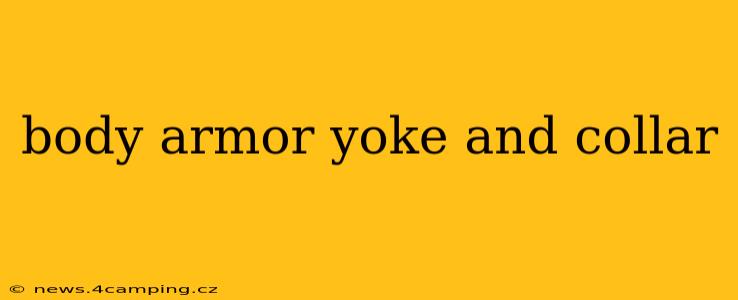Body armor, designed to protect vital organs and areas of the body, incorporates several key components. Two often overlooked, yet crucial, elements are the yoke and the collar. These strategically placed sections provide critical protection extending beyond the standard front and back panels. This article will delve into the function, design, and importance of body armor yokes and collars, answering frequently asked questions surrounding their role in personal protection.
What is a Body Armor Yoke?
The yoke of a body armor vest is the section that connects the front and back panels, typically across the shoulders and upper back. Think of it as the "bridge" holding the main panels together. Its primary function is to provide continuous protection, preventing gaps or weak points where ballistic threats might penetrate. This is especially important in areas often overlooked by standard vest designs, offering crucial coverage for the shoulders and upper back – vital areas often exposed during movement and engagements. The design of the yoke varies depending on the type of armor (soft armor, hard armor, or a hybrid). Some yokes seamlessly integrate with the main panels, while others are separate but strategically connected.
What is a Body Armor Collar?
A body armor collar is an extension of the main body armor designed to protect the neck and throat. This critical area is vulnerable to a variety of threats, and a collar significantly enhances overall protection. Like the yoke, the design and materials used in a collar depend on the specific vest and its intended use. It can be a separate component attached to the main vest or integrated directly into the yoke or even the front panel. Some collars are flexible and offer a degree of comfort and movement, while others provide more robust, rigid protection.
What is the purpose of a body armor yoke and collar?
The purpose of a body armor yoke and collar is to provide comprehensive protection against ballistic threats by bridging gaps and covering vulnerable areas. The combination addresses the limitations of basic front and back panels, providing a more holistic and effective defense:
- 360° Protection Enhancement: The yoke and collar greatly improve the protection level by extending coverage beyond the standard front and back panels.
- Shoulder and Neck Protection: These elements shield the shoulders and neck, critical areas often vulnerable during dynamic movements and engagements.
- Gap Closure: Yokes prevent gaps between the main panels, ensuring consistent protection across the upper torso.
- Improved Ballistic Performance: A well-designed yoke and collar contribute to the overall ballistic performance of the armor, preventing projectile deflection or penetration.
What type of materials are used in body armor yokes and collars?
The materials used in body armor yokes and collars are determined by the level of protection required and the type of threat expected. Commonly used materials include:
- Aramid Fabrics (Kevlar, Twaron): These high-strength fibers provide excellent protection against ballistic threats.
- Polyethylene (UHMWPE): This lightweight yet incredibly strong material is often used in advanced body armor.
- Ceramic Plates: Used in hard armor, ceramic plates offer high-level protection against high-velocity rounds.
- Composite Materials: Modern body armor often utilizes composite materials that combine the benefits of different materials for optimized protection and weight reduction.
How do I choose a body armor vest with a yoke and collar?
Choosing a body armor vest with a yoke and collar involves considering several factors:
- Threat Level: The level of protection required dictates the materials and construction of the yoke and collar.
- Comfort and Mobility: A well-designed yoke and collar should not restrict movement significantly.
- Fit and Sizing: Proper fit ensures optimal protection and comfort.
- Certification and Standards: Ensure the vest meets relevant industry standards and certifications.
- Intended Use: The specific application of the vest (law enforcement, military, security) influences design requirements.
Are body armor yokes and collars necessary?
While not always mandatory, body armor yokes and collars significantly enhance overall protection by covering vulnerable areas. Their inclusion is highly recommended, especially in high-risk situations where a higher degree of protection is paramount. The added protection provided often outweighs any slight increase in weight or cost.
This comprehensive overview of body armor yokes and collars should provide a clearer understanding of their significance in enhancing personal protection. Remember, safety and the selection of appropriate body armor are critical considerations, and professional guidance should always be sought when making such important decisions.
